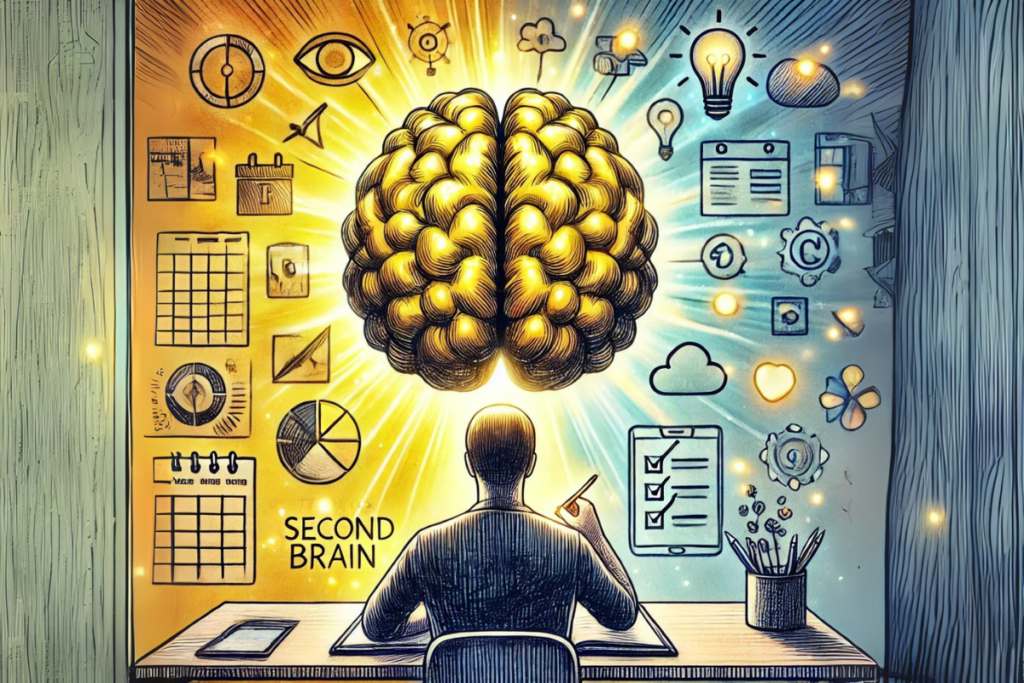We live in a world of constant distractions. Emails, social media, deadlines, and endless to-do lists can feel overwhelming, leaving your mind cluttered and unable to focus. Enter the concept of the Second Brain—a simple yet powerful system to help you offload, organize, and prioritize your thoughts and tasks so your mind is free to focus on what really matters.
Inspired by productivity systems like David Allen’s Getting Things Done (GTD), the Second Brain concept is all about creating a trusted system for capturing and organizing everything vying for your attention. In this article, I’ll share what a Second Brain is, how it can transform your productivity, and my personal best practices for using it effectively. Spoiler: It’s easier to implement than you think!
What Is a Second Brain?
A Second Brain is an external system for storing your thoughts, ideas, and tasks, so your actual brain doesn’t have to hold onto them. Think of it as a mental dumping ground where you write down:
- Every concern distracting you.
- Every idea or inspiration that pops up.
- Every pending task or to-do that keeps nagging at you.
This concept echoes the principles in Getting Things Done, where David Allen emphasizes the importance of capturing everything on your mind in a reliable system. By doing so, you free your brain from having to “remember” tasks, allowing it to focus on more creative and strategic thinking.
Your Second Brain can take many forms: a physical notebook, a digital tool like Evernote, Notion, or even a simple Excel spreadsheet. The key is to offload and organize, creating mental space for deep, focused work.
How a Second Brain Boosts Productivity
- Frees Up Mental Space: Your brain isn’t designed to store everything. By offloading thoughts and tasks, you give it room to think creatively and strategically.
- Example: Instead of remembering to call a client or schedule a meeting, you write it down. This allows you to focus entirely on the report you’re working on.
- Promotes Deep Work: Once your mind is free from distractions, you can fully immerse yourself in your current task.
- Example: You’re brainstorming for a new project, and instead of worrying about unrelated deadlines, your Second Brain holds everything for you to address later.
- Encourages Organization: Regularly updating your Second Brain helps you stay on top of tasks, goals, and priorities.
My Best Practices for Using a Second Brain
Here’s how I’ve successfully implemented a Second Brain system using Evernote and Excel (and how I plan to explore Notion soon). Regardless of the tool the most important step is your conviction to use a system like this for you te be more productive and reduce stress:
1. Daily Dump and Prioritize
- What I Do: Each morning, I write down everything on my mind.
- Concerns.
- Pending tasks.
- Ideas.
- I then create a to-do list for the day and prioritize tasks based on urgency and importance.
- Tip: Start with the most important tasks to make the biggest impact early in the day.
2. Time Blocking and Scheduling
- What I Do: I put key tasks and activities on my calendar with time blocks for each. This ensures that I stay on track and allocate enough time for each activity.
- Tip: Use reminders to keep you accountable.
3. Medium-Term Backlogs
- What I Do: I maintain a backlog of:
- Ideas and inspirations for future projects.
- Pending issues or tasks that don’t require immediate attention.
- Strategies for different initiatives.
- Tip: Review this backlog weekly to decide which items to prioritize next.
4. Personal and Family Priorities
- What I Do: My Second Brain isn’t just about work—I also include:
- Family time and commitments.
- My weekly plan for workouts, running, and physical activity.
- Tip: Treat personal goals with the same importance as professional ones to maintain balance.
5. Tools I Use
- Evernote: For capturing quick thoughts, organizing tasks, and creating backlogs.
- Excel: For managing detailed lists and tracking medium- and long-term goals.
- Plan to Explore Notion: I’m excited to explore its features for visual organization and project tracking.
The Key to Success: Make It a Habit
The power of a Second Brain lies in consistency. Writing things down is just the first step—you also need to review, organize, and act on them regularly.
Here’s how I maintain the habit:
- Daily Check-In: Update your Second Brain every morning and plan your day.
- Weekly Review: Reflect on your notes, assess progress, and adjust priorities for the week ahead.
- Adapt to Your Goals: Organize your notes in a way that aligns with what you’re trying to achieve, whether it’s professional growth, personal development, or family balance.
Why I’m Exploring Notion
While Evernote and Excel have been my go-to tools, I’m planning to explore Notion because of its flexibility and ability to integrate various types of data. With Notion, I hope to:
- Create a visually appealing dashboard to track my projects and goals.
- Integrate multiple backlogs into one organized system.
- Experiment with collaborative features for future NateGrowth projects.
Final Thoughts: Building Your Own Second Brain
Creating a Second Brain isn’t about following rigid rules—it’s about finding a system that works for you. Whether you use a notebook, an app, or a spreadsheet, the key is to make it a daily habit and organize it in a way that aligns with your goals.
By offloading the clutter and distractions into a trusted system, you empower yourself to focus on what truly matters. Start small—write down a few things distracting you today, prioritize them, and see how it feels to free your mind. Then, keep building from there.
What tools do you use to stay productive? Have you tried creating a Second Brain? Share your tips with me using the hashtag #NateGrowth, and let’s grow smarter together.

